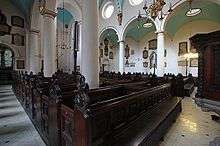Te Deum in C (Britten)
The Te Deum in C is a sacred choral composition by Benjamin Britten, a setting of the Te Deum on the English text from the Book of Common Prayer. Britten wrote it in 1934 between 11 July and 17 September, scored for treble solo, four-part choir (SATB) and organ.
| Te Deum in C | |
|---|---|
| by Benjamin Britten | |
 St Michael's, Cornhill, location of the work's premiere | |
| Key | C major |
| Text | Te Deum |
| Language | English |
| Composed | 1934 |
| Performed | 13 November 1935: St Michael's, Cornhill, London |
| Scoring | |
History and versions
Britten dedicated the work: "Written for Maurice Vinden and the Choir of St Mark's, N. Audley St, London". It was first performed in concert at the medieval Church of St Michael's, Cornhill, London, on 13 November 1935 by the St Michael's Singers and organist George Thalben-Ball, with soprano May Bartlett, conducted by Harold Darke.[1] The work was among Britten's first compositions to be published, by Oxford University Press.[2]
Commissioned by the BBC, Britten orchestrated the work in 1936 between 14 and 20 January, for harp or piano and string orchestra. This version was first performed in concert at the Mercury Theatre, London, on 27 January 1936 in the Lemare concert series, by the Choir of St Alban the Martyr, Holborn, conducted by Reginald Goodall. Britten played the viola in the unnamed orchestra.[3]
Britten composed Jubilate Deo in C in 1961 as a companion piece.[1]
Music
The music in one movement, which takes about 9 minutes to perform,[1] is based on an ostinato of the organ in the beginning and in the reprise after a contrasting middle section.[4][5] Beginning pianissimo, the voices build chords from bass to soprano. Barry Holden describes: "In the opening pages it adheres steadfastly to a chord of C major in the choral parts, and builds its musical interest without traditional use of harmonic progression, but by use of short motifs which are constantly reworked".[2] Gradually more intense,[5] the voices reach a climax on "Holy, Holy, Holy".[4] After a general rest, they proclaim in unison with the organ: "Lord God of Sabaoth".[5] In the middle section the soloist addresses God softly: "Thou art the King of Glory, O Christ". The choir joins, not only in this line, for "O Christ", repeating that pattern also for the following acclamations up to "Thou didst open the Kingdom of Heav'n to all believers", finally just inserting "Christ".[5] Holden comments: "The haunting treble solo which sets the individual against the chorus is a typically ingenious idea."[2] A second climax is reached before a quiet ending. Paul Spicer summarizes in his commentary for the publisher Boosey & Hawkes: "It has drama, energy, variety, and clarity and integrity of structure".[4]
References
- "Te Deum in C". brittenproject.org. Retrieved 16 November 2013.
- Holden, Barry. "Benjamin Britten (1913-1976) / Choral Works". Naxos. Retrieved 16 November 2013.
- "Te Deum in C (Orchestral version)". brittenproject.org. Retrieved 16 November 2013.
- Spicer, Paul. "Te Deum in C in Britten Choral Guide with Repertoire Notes by Paul Spicer" (PDF). Boosey & Hawkes. p. 9. Retrieved 16 November 2013.
- Te Deum in C (PDF). Oxford Church Services. Retrieved 18 November 2013.